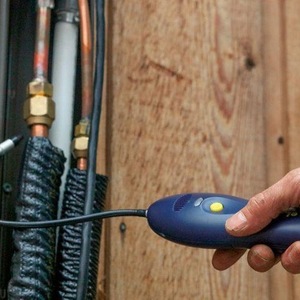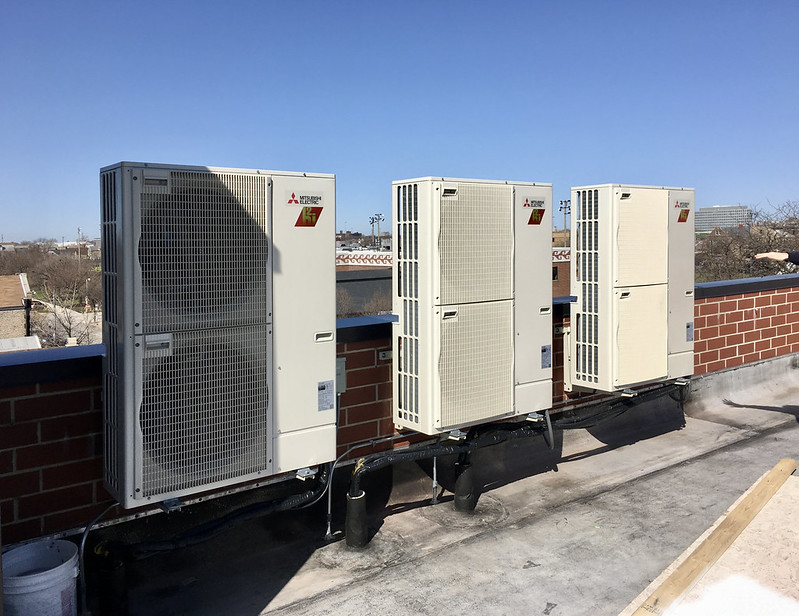
Refrigerant leaks are one of the most common causes of callbacks for inverter-driven heat pump systems. They can present in various ways: as complaints of inadequate heating or cooling; as error codes and intermittent lockouts; as iced-up indoor or outdoor coils; and as high energy bills. Left unaddressed, refrigerant leaks can significantly reduce equipment lifespan.
Beyond their immediate consequences for contractors and end-users, refrigerant leaks are a serious environmental issue. R-410A, the refrigerant used in most new heat pumps in North America, has a 100-year global warming potential 2088 times that of CO2. If the 3 to 4 pounds of R-410A in a small ductless heat pump system were to escape into the atmosphere, it would cause as much warming as a gasoline car’s annual emissions. Larger multi-zone systems contain more refrigerant; they also have more piping connections, and thus more opportunities for leaks.
Problem scope and solution
A 2014 report by the British consulting firm Eunomia provides data on the magnitude of the problem. The authors report that 10% of the residential heat pumps they surveyed had detectable leaks and that 3.8% of the total refrigerant charge was lost annually. Catastrophic leaks, in which systems lost 50% or more of their initial charge, were responsible for the vast majority—about 92%—of refrigerant losses.
Heat pumps, properly installed, offer clear benefits for both consumers and the climate. As environmental groups, utilities, and government agencies push for their widespread adoption, preventing refrigerant leaks, especially catastrophic ones, needs to be a priority. Problems caused by refrigerant leakage could impede customer acceptance of heat pump technology. And climate impacts of refrigerant leaks could cancel out, to some extent, the CO2 emissions reductions heat pumps offer.
In an article we wrote recently for ASHRAE journal, Ian Shapiro and I outline a comprehensive strategy to reduce refrigerant leaks from…
Weekly Newsletter
Get building science and energy efficiency advice, plus special offers, in your inbox.

This article is only available to GBA Prime Members
Sign up for a free trial and get instant access to this article as well as GBA’s complete library of premium articles and construction details.
Start Free TrialAlready a member? Log in















19 Comments
Does anyone have experience with the ProPress refrigerant systems? Something like RLS, Zoomlock/MaxiPro, etc. - even though the cost is higher, could a press-on mechanical fastening system help limit potential refrigerant leaks?
We haven't tried ZoomLock yet, but I've been following discussions in chat groups I'm in, and it seems to be a very good product. We are about to try Rectorseal Pro-Fit push connect fittings, which do not require a special press tool. Our rep is very enthuisiastic about these. I'm planning to put these through some testing and see how they do.
Great article--thanks for sharing your information! I'm curious what you end up finding out about press fittings. I got these slides from somebody at a NESEA conference, which indicate that a press fitting is much more likely to create a leak-free joint (compared to flare), especially at larger pipe sizes, and with less-experienced technicians.
Jon, it seems to me an article on your experiments/findings on press fittings is in order.
Yes! I'm really interested to get some firsthard data.
Thank you, Kohta. This is an interesting slide. The failure rates they're listing for flares seem really high for properly trained installers. That being said, torqueing large diameter flares in a controlled way can be really difficult when working overhead or in tight quarters. If the push-fit fittings check out, I expect that we'll be using them frequently, especially for difficult locations.
If you had an installer commission your heat pump system who did not perform all of these tests, would you recommend scheduling an HVAC tech from another company come out and check everything over? We are 8 months in and have had no problems, but we would be remiss to not avoid a leak that results in failure in the upcoming heating season. I assume it is no trouble to evacuate the system and do all of this over again, so long as one is willing to pay the big bucks for it.
Once the system has been commissioned, I'd focus on non-invasive testing, rather than opening up the refrigerant circuit, which might create possibilities for new accidental losses and leaks. If you have a tech go over all the flare connections and service valves with an electronic sniffer, I think you'll be pretty well covered. If the system seems to be operating well, I'd be comfortable waiting and having this done as part of your annual maintenance.
Thanks for another excellent article Jon.
I'm curious how often you encounter leaking joints in flares that have been properly formed and torqued?
Thanks Norman! When I was starting out, I had a lot of leaky flares, probably more than one in ten. Getting immediate feedback, especially from the nitrogen and bubble tests, helped me get better. With good tools, training, and attention to all the steps (cutting and deburring are really important), I've reduced that number quite a bit; at this point it's well below 5%, maybe closer to 1%. But we're also installing a lot of multi-head systems, which could have anywhere from 8 to 20 or more flares, so even a 1% failure rate would lead to a lot of refrigerant losses if they're not caught during testing.
That pretty much mirrors my experience. A digital torque wrench made a very big difference for us. And I braze lineset coupling joints, limiting flare connections to the compressor and indoor head.
I've had 2 systems I know of out of maybe 70+ that seemed to develop leaks at the compressor connection several years after installation. I think in both cases the exterior lineset took hits from falling ice.
Not much has been said about brazing the connections, can it replace all of the fittings?
The manufacturers I've heard from on this don't officially recommend it. I think the big issue is that they can't be sure installers will flow nitrogen during brazing to prevent oxidation in the tubing. However, I do know some installers that prefer brazing. At the indoor heads, you can cut off the flares and braze the linesets directly to the stubs. You will still need flares at the branch box and outdoor unit, but you may be able to cut the number of flares per system by up to half.
Jon,
Thanks for the great article. There is really not enough focus put on making reliable connections on these systems. I have to fight techs to do a proper commissioning on system, most just want to do a single evac and release without any pressure testing.
With this type of install, I've had systems loose refrigerant in under 2 years. The problematic part not mentioned is that once the refrigerant leaks out and moisture makes it in the system, just refilling the system will lead to eventual failure. Lot of times there is no choice but replace the whole unit. Lot of cost to the owner that could have been easily avoid with proper install.
Thanks for this excellent article Jon. One after another, your articles are hitting on really important issues, and providing useful, thorough information with thoughtful commentary.
I want to add that another approach is to use monobloc air-to-water heat pumps with all refrigerant connections made at the factory and with less refrigerant in the system.
As we move to refrigerants that have lower GWP, but are more flammable, the some of the reasons for concern about leaks will shift, but it will still be very important to avoid them. And the idea of having a factory sealed unit, located outside of the envelope, will become even more attractive.
“[Deleted]”
AC is one of the biggest changes we need to combat Global Warming. I wonder about the new DIY mini-split units now widely available online and in BigBox stores? Could be very significant. They have prebuilt line sets of different lengths, as needed, with couplers that keep the lines from leaking when installing. The savings in the US is significant vs HVAC install. Reports of function for some high-selling brands seem supportive but may not tell the true story if you get a slow leak that takes a few years to cause problems.
The SEER ratings are 20 or better on some of the better units. In dry mode, they are effective at dehumidifying for very little energy use. 35-40% humidity at 80 or so degrees is a super low energy setting (20 SEER) and comfortable. Humidity is quickly equilibrated in an open home, unlike temperature.
Good mini-splits are very quiet indoors and out, unlike the old compressor next door that will keep you up at night if you choose to sleep with the window open. Not a trivial benefit in my book when you don't want to run the AC for 6-7 months straight.
Jon,
Thanks for the article. I will be having some Mitsubishi mini-splits installed by a company that I vetted and seems to do decent work. I asked them about your 4 tests and they said they follow Mitsubishi recommended installation practices. From your understanding, does this include the 4 tests?
Jon, great articles across the board in recent years.
We've been running into major line set leakage on systems typically between 5-10 years post installation which appears to be due to moisture getting in between the copper and the white colored polyethylene insulation. When this happens it seems to create an acidic environment and over time will corrode the copper eventually leading to leakage. The best write up on it I've found is https://hvacrschool.com/ductless-line-sets-and-corrosion/.
I know now most line set products come with black elastomeric insulation but we still have miles and miles of the white PE type out there that could be already leaking or possibly due to start leaking soon. I'd be curious what you're experience has been with this issue and if you've got any suggestions for what folks can do to either identify this or prevent it from manifesting. Of course the big question also being, shouldn't the manufacturers of this product be held responsible for this?
Log in or become a member to post a comment.
Sign up Log in